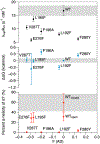Allosteric Inhibition of PTP1B by a Nonpolar Terpenoid
- PMID: 36223525
- PMCID: PMC10040085
- DOI: 10.1021/acs.jpcb.2c05423
Allosteric Inhibition of PTP1B by a Nonpolar Terpenoid
Abstract
Protein tyrosine phosphatases (PTPs) are promising drug targets for treating a wide range of diseases such as diabetes, cancer, and neurological disorders, but their conserved active sites have complicated the design of selective therapeutics. This study examines the allosteric inhibition of PTP1B by amorphadiene (AD), a terpenoid hydrocarbon that is an unusually selective inhibitor. Molecular dynamics (MD) simulations carried out in this study suggest that AD can stably sample multiple neighboring sites on the allosterically influential C-terminus of the catalytic domain. Binding to these sites requires a disordered α7 helix, which stabilizes the PTP1B-AD complex and may contribute to the selectivity of AD for PTP1B over TCPTP. Intriguingly, the binding mode of AD differs from that of the most well-studied allosteric inhibitor of PTP1B. Indeed, biophysical measurements and MD simulations indicate that the two molecules can bind simultaneously. Upon binding, both inhibitors destabilize the α7 helix by disrupting interactions at the α3-α7 interface and prevent the formation of hydrogen bonds that facilitate closure of the catalytically essential WPD loop. These findings indicate that AD is a promising scaffold for building allosteric inhibitors of PTP1B and illustrate, more broadly, how unfunctionalized terpenoids can engage in specific interactions with protein surfaces.
Figures






References
-
- Östman A; Hellberg C; Böhmer FD Protein-tyrosine phosphatases and cancer. Nat. Rev. Cancer 2006, 6, 307–320. - PubMed
-
- Zhu Z; Liu Y; Li K; Liu J; Wang H; Sun B; Xiong Z; Jiang H; Zheng J; Hu Z Protein Tyrosine Phosphatase Receptor U (PTPRU) Is Required for Glioma Growth and Motility. Carcinogenesis 2014, 35, 1901–1910. - PubMed
-
- Mustelin T; Vang T; Bottini N Protein Tyrosine Phosphatases and the Immune Response. Nat. Rev. Immunol 2005, 5, 43–57. - PubMed
Publication types
MeSH terms
Substances
Grants and funding
LinkOut - more resources
Full Text Sources
Research Materials
Miscellaneous

